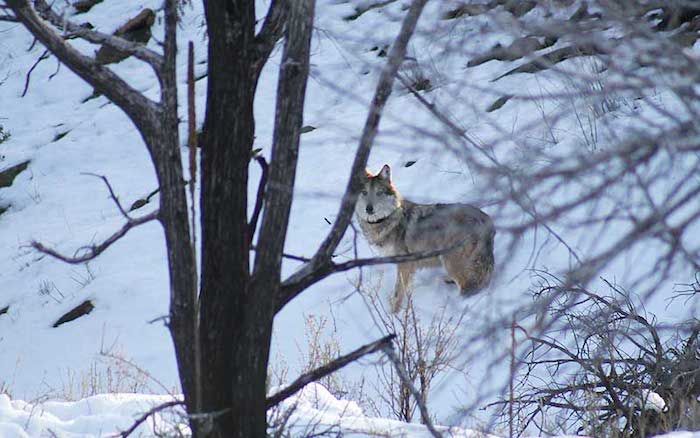
Room to Roam for Mexican WolvesDear Guardian,
In the late spring of 2004, a pioneering young Mexican wolf and her mate staked out new territory on the western slope of New Mexico’s San Mateo Mountains. The pair, two of the less than 50 Mexican wolves in existence in the wild, preyed on the mountain range’s abundant elk and deer and started a family—the San Mateo Pack—in their new home overlooking the Aldo Leopold Wilderness to the west and the Rio Grande valley to the east. The only problem for the newly formed San Mateo Pack is that they settled outside an invisible and arbitrary boundary that the U.S. Fish and Wildlife Service set determining where Mexican wolves may, and may not, live. (Note: To receive our Executive Director’s blog in the future please subscribe.) The wolves bothered no one—not even the area’s few ranchers—but still federal wolf bureaucrats trapped and relocated the pair in August 2004 and again in the summer of 2005 to an area within the arbitrary boundaries the government designated as acceptable for Mexican wolves to inhabit. Sadly, one of those translocations caused the death of their young pups. Wolf scientists knew the boundary was arbitrary and recommended over and over again that the boundary be removed and Mexican wolves be granted the room to roam they need to fully recover as a species. This January the Service updated its Mexican wolf regulations. Finally heeding the wisdom of wolf ecologists, they removed the old boundary. Incredibly, the Service created another equally arbitrary boundary (although encompassing a larger area) that once again limits where Mexican wolves can live. As a point of reference, no other endangered large carnivore, much less one of the most endangered ones, has a boundary for where it can and cannot live. That’s why earlier this month WildEarth Guardians, joined by the New Mexico Wilderness Alliance and Friends of Animals, and represented by our own attorneys and the Western Environmental Law Center filed a lawsuit in federal court against the Service to overturn the artificial geographic limits, and many other equally arbitrary and deeply flawed aspects of the new rule governing Mexican wolf recovery in the American Southwest. While geographic limits undermine wolf conservation the rule’s newly designated artificial cap on the Mexican wolf population really gets my blood to boil. At the 11th hour in the agencies’ multi-year planning process, and with essentially no opportunity for public input, the Service adopted a population cap of 300-325 wolves! At a time when the science is saying we need more wolves in many more places why does the Service continue to come up with half measures based on half-truths? But the Service’s new Mexican wolf regulations get even worse. The new rule flagrantly ignores the Endangered Species Act’s requirement that reintroduced, or “experimental” populations, that are “essential” to the species survival in the wild be designated as “essential” rather than the much less protective “non-essential” designation under the Act. How can the only wild Mexican wolf population not be essential to the species survival in the wild? It’s outrageous! The Service cynically claims that animals in zoos and breeding facilities somehow ensure the species’ survival even when the Endangered Species Act requires that it make the determination of “essential/non-essential” based on populations in the wild. That’s why, even though thousands of people and dozens of environmental groups asked the agency to consider the benefits of the “essential” designation when it completed its Environmental Impact Statement, it ignored those pleas. The more protective “essential” designation would mean that some of the biggest threats to the Mexican wolf—such as coyote hunting, trapping, livestock grazing permitted by the U.S. Forest Service and activities carried out by the federal animal damage control agency—would be subject to greater scrutiny. Incredibly the original alpha female of the San Mateo Pack is still alive, though her first mate was killed by a government trapper and another was killed by a poacher. She now roams the Mangas Mountains, with another mate, in the northern portion of the Gila National Forest. While the current, politically defined wolf recovery boundary at Interstate-40—a mere 85 miles to her north—may no longer threaten her given her age, it may well endanger her off-spring as they seek to reclaim their historic homelands just as she and her mate once did. George Santayana, the Spanish philosopher and essayist once said: “those who cannot remember the past are condemned to repeat it.” The San Mateo Pack’s story of tragedy, recovery, and resilience is history that we will not forget. That’s why we’re fighting in court to overturn the artificial geographic boundary, the arbitrary population cap and the “non-essential” designation—and other flaws in the Mexican wolf recovery framework as well. We believe that the foundation for the recovery of the Mexican wolf simply needs to be stronger. With your voice, and ours, we’ll get there. For the wild,
John Horning
San Mateo Female photo credit: Mexican wolf Interagency Field Team |
|
|
Stay Connected: WildEarth Guardians' mission is to protect and restore the wildlife, wild places, wild rivers, and health of the American West. Home | Wildlife | Wild Places | Wild Rivers | Climate & Energy | About Us | Take Action | Donate ARIZONA * CALIFORNIA * COLORADO * MONTANA * NEW MEXICO * OREGON * UTAH * WYOMINGMAIN OFFICE: 516 Alto Street, Santa Fe, NM 87501 p) 505.988.9126 f) 505.213.1895 © WildEarth Guardians. Banner photo credit: Adriel Heisey If you received this message from a friend, you can subscribe Unsubscribe or change the number of emails you receive by Managing Your Subscription View this message as a webpage for social sharing
|



